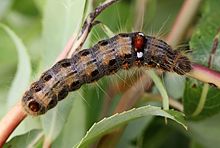Black-spotted moth
| Black-spotted moth | ||||||||||||
|---|---|---|---|---|---|---|---|---|---|---|---|---|

Black-spotted moth ( Clostera anachoreta ), female |
||||||||||||
| Systematics | ||||||||||||
|
||||||||||||
| Scientific name | ||||||||||||
| Clostera anachoreta | ||||||||||||
| ( Denis & Schiffermüller , 1775) |
The black-spotted grouse ( Clostera anachoreta ), also called black-spotted drake tail , black -spotted osier moth or large drake tail , is a butterfly ( moth ) from the tooth moth family (Notodontidae).
features
butterfly
The wingspan of the moth is 32 to 40 millimeters. The basic color of the forewings is gray-brown. They are provided with four thin white cross lines. A large dark brown apical spot, which is cut through by the rearmost white transverse line, clearly stands out. There are one or two small black-brown spots near the interior corner. The hind wings are gray-brown without drawing. The thorax has a head of hair on its back. The tip of the abdomen is provided with an anal bush. In males it usually consists of two long tufts. The antennae of the males are long, those of the females are combed very short. The proboscis is stunted.
egg
The egg is brown-gray, flatly arched and has a brown transverse band.
Caterpillar
Adult caterpillars are brownish in color, have a light back and are hairy yellow-gray. They have narrow, dark back and side back lines as well as reddish side spots. There are bushy red bumps on the fourth and eleventh segments. A white spot can be seen on each side next to the cusp of the fourth segment.
Doll
The doll is red-brown, short and stocky. It shows a pointed cremaster and black wing sheaths.
Similar species
The drake-tailed moth ( Clostera curtula ) is somewhat smaller and differs primarily through the red-brown colored apical spot that ends at the rearmost white transverse line and the lack of black-brown spots at the inner corner.
distribution and habitat
The black-spotted moth is widespread in Europe and occurs eastwards through northern Asia to China , Japan and Korea . It can still be found at heights of up to 1,600 meters. The species prefers to colonize stream and river valleys as well as floodplain and swamp forests.
Way of life
The moths form two generations a year, which can be found in April and May and from June to August. Whether specimens found later in the year belong to other generations still needs to be clarified. In Northern Europe they are univoltin and fly in June and July. During the day, the moths sit in a resting position with their wings folded roof-shaped over the abdomen on trunks and twigs and stretch the tip of the abdomen with the anal bush up through between the wings. At night they visit artificial light sources . The caterpillars feed on the leaves of various poplar ( Populus ) and willow species ( Salix ). They like to hide in rolled and spun leaves. Pupation takes place in a white-gray cocoon . The last generation pupa hibernates.
Danger
The black-spotted moth is widespread in the German federal states, but is particularly rare in the north and is on the red list of endangered species on the pre-warning list. In Baden-Württemberg , however, it is not considered endangered.
supporting documents
Individual evidence
- ↑ Walter Forster, Theodor A. Wohlfahrt: The butterflies of Central Europe. Volume 3: Weirdos and Swarmers. (Bombyces and Sphinges). Franckh'sche Verlagshandlung, Stuttgart 1960, DNB 456642196 .
- ↑ Josef J. de Freina: The Bombyces and Sphinges of the West Palaearctic. Volume 1. Noctuoidea, Sphingoidea, Geometoidea, Bombycoidea. EFW Edition Research & Science Verlag GmbH, Munich 1987, ISBN 3-926285-00-1
- ↑ a b c Günter Ebert (Ed.): The Butterflies of Baden-Württemberg Volume 4, Moths II (Bombycidae, Endromidae, Lasiocampidae, Lemoniidae, Saturniidae, Sphingidae, Drepanidae, Notodontidae, Dilobidae, Lymantriidae, Ctenidae),. Ulmer Verlag, Stuttgart 1994, ISBN 3-8001-3474-8
- ↑ Federal Agency for Nature Conservation (Ed.): Red List of Endangered Animals in Germany . Landwirtschaftsverlag, Münster 1998, ISBN 3-89624-110-9 .
literature
- Günter Ebert (Ed.): The Butterflies of Baden-Württemberg Volume 4, Moths II (Bombycidae, Endromidae, Lasiocampidae, Lemoniidae, Saturniidae, Sphingidae, Drepanidae, Notodontidae, Dilobidae, Lymantriidae, Ctenuchidae, Nolidae). Ulmer Verlag, Stuttgart 1994, ISBN 3-8001-3474-8
- Josef J. de Freina: The Bombyces and Sphinges of the West Palaearctic. Volume 1. Noctuoidea, Sphingoidea, Geometoidea, Bombycoidea. EFW Edition Research & Science Verlag GmbH, Munich 1987, ISBN 3-926285-00-1
- Walter Forster , Theodor A. Wohlfahrt : The butterflies of Central Europe. Volume 3: Weirdos and Swarmers. (Bombyces and Sphinges). Franckh'sche Verlagshandlung, Stuttgart 1960, DNB 456642196 .
- Manfred Koch : We determine butterflies. Volume 2: Bears, Spinners, Swarmers and Drills in Germany. 2nd, expanded edition. Neumann, Radebeul / Berlin 1964, DNB 452481929 .
- Arno Bergmann: The large butterflies of Central Germany. Volume 3: Weirdos and Swarmers. Distribution, forms and communities. Urania-Verlag, Jena 1953, DNB 450378365 .
- Hans-Josef Weidemann, Jochen Köhler: Moths, Spinners and Swarmers . Naturbuch-Verlag, Augsburg 1996, ISBN 3-89440-128-1
Web links
- Lepiforum eV - taxonomy and photos
- www.funet.fi - dissemination
- www.schmetterlinge-deutschlands.de - endangerment
- Clostera anachoreta at Fauna Europaea. Retrieved May 12, 2013


